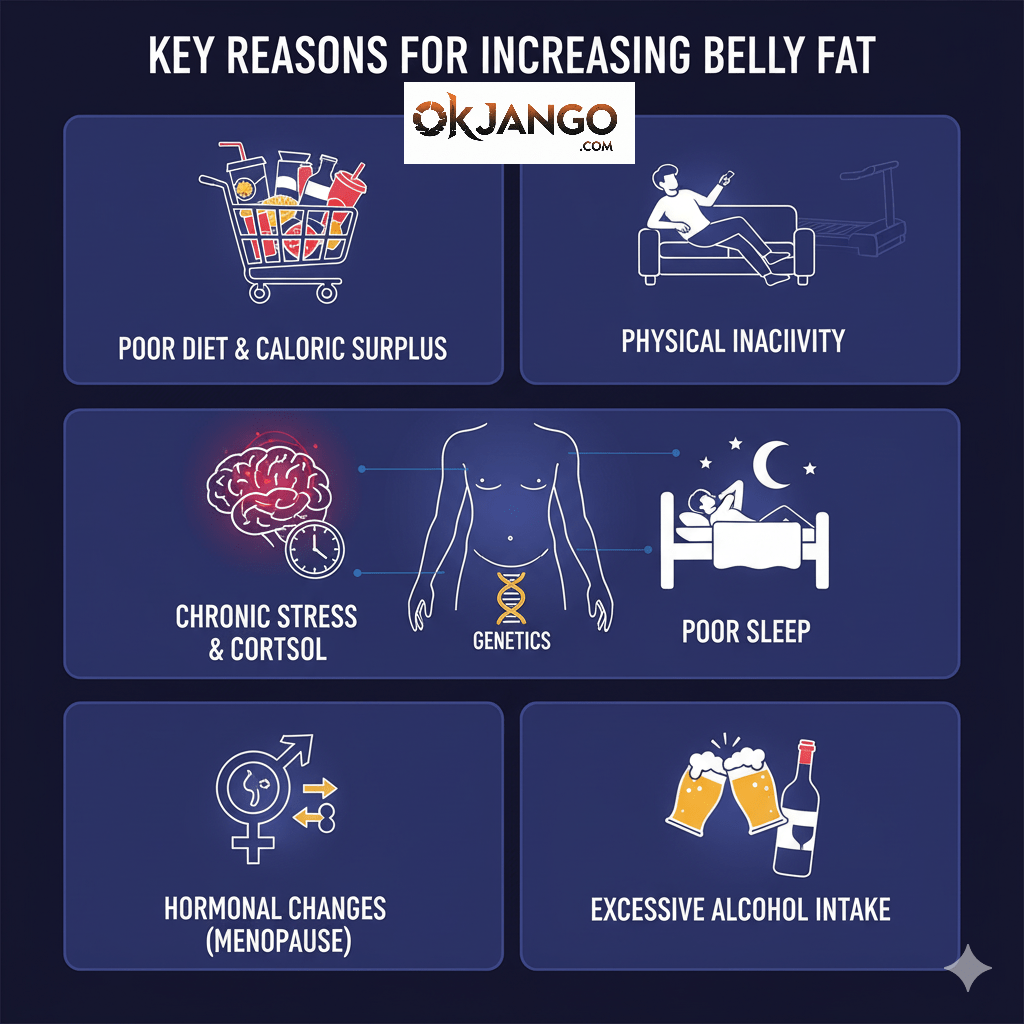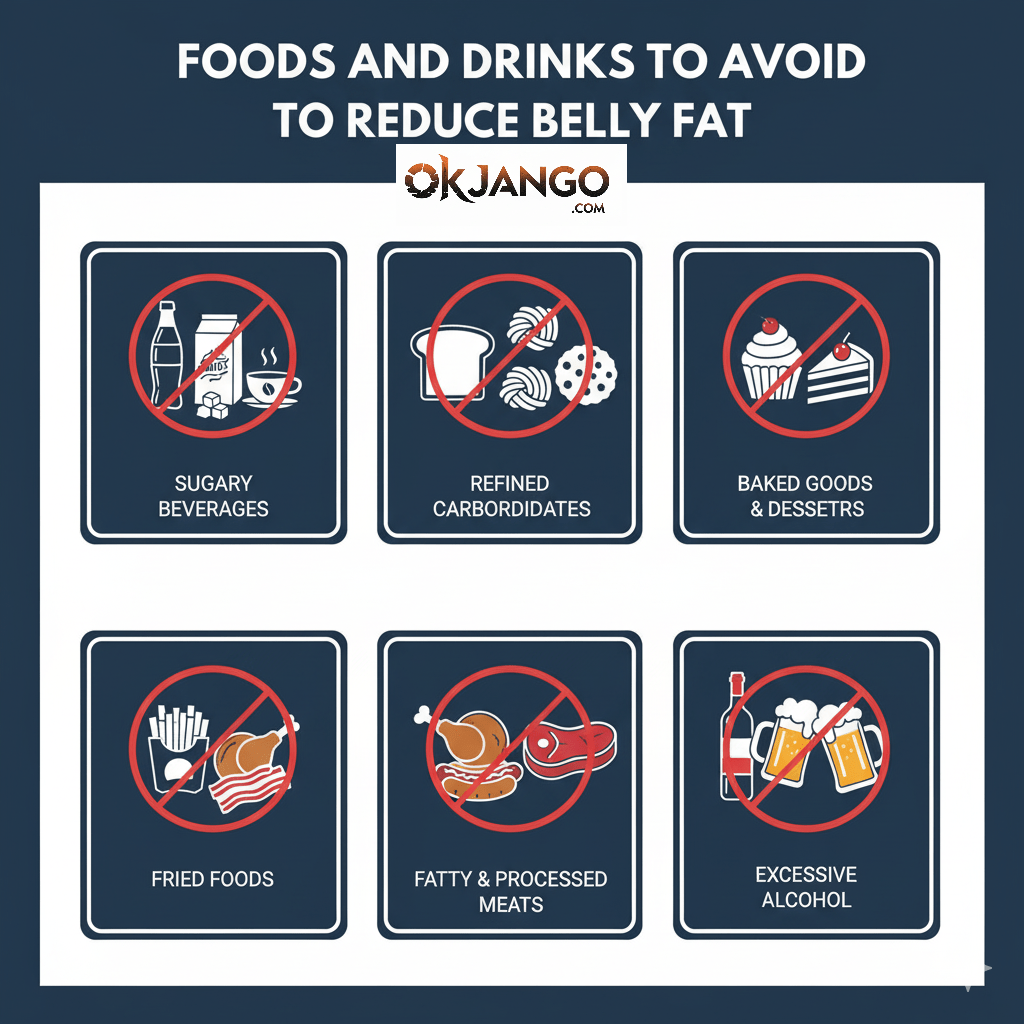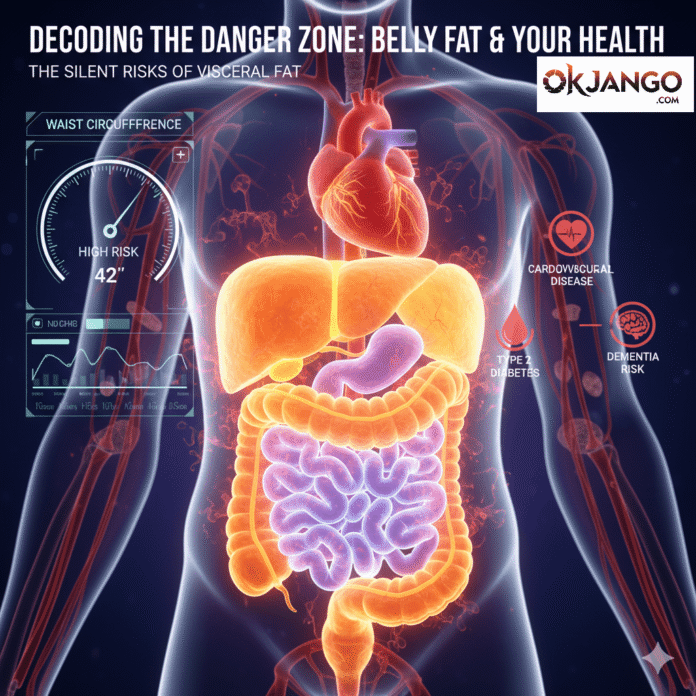An expanding waistline is a common experience, but it’s often more than just a cosmetic concern. The fat stored around your midsection, particularly a type called visceral fat, is a serious health matter. Understanding what causes the belly fat and the risks it poses is the first step toward a healthier life.
What is Belly Fat?
When people talk about “belly fat,” they’re usually referring to two types:
- Subcutaneous Fat
This is the visible fat that lies just under the skin. You can pinch it. While excess subcutaneous fat is a sign of being overweight, it’s generally considered less harmful than the deeper type.
- Visceral Fat
This is the real danger zone. Visceral fat is stored deep within your abdomen, surrounding vital organs like your liver, pancreas, and intestines. It is metabolically active, releasing hormones and inflammatory substances that interfere with normal body function.
This is the fat most strongly linked to serious health risks.
A simple measurement can give you a general idea of your risk. For most people, a waist circumference greater than 35 inches (89 cm) for women and 40 inches (102 cm) for men is considered high-risk.
Key Reasons for Increasing Belly Fat

| Category | Specific Reason | Description and Impact |
| Diet | Caloric Surplus & Poor Diet | Regularly eating more calories than you burn, especially from foods high in refined sugars and unhealthy fats, leads directly to fat storage, often in the abdomen. |
| Activity | Physical Inactivity | A sedentary lifestyle means lower calorie burn. It also causes a loss of muscle mass, which slows metabolism and makes it harder to maintain a healthy weight. |
| Hormones | Chronic Stress / High Cortisol | Sustained stress elevates the hormone cortisol. High cortisol levels are known to encourage the body to store calories specifically as visceral fat around the organs. |
| Hormones | Age and Menopause | For women, a drop in estrogen during and after menopause causes fat storage to shift away from the hips and thighs toward the abdomen. |
| Lifestyle | Poor Sleep | Insufficient or low-quality sleep (less than 7 hours) disrupts hormones that regulate appetite (ghrelin and leptin), increasing hunger and promoting fat gain. |
| Lifestyle | Excessive Alcohol Intake | Alcohol provides empty calories. High consumption is specifically linked to an increase in visceral fat deposition. |
| Genetics | Genetic Predisposition | Some individuals are genetically predisposed to storing fat in the abdominal area, regardless of their overall body weight. |
Foods and Drinks to Avoid to Reduce Belly Fat
To effectively reduce belly fat, focus on eliminating sources of empty calories, refined sugars, and unhealthy fats from your diet.
| Food/Drink Category | Examples to Avoid | Why They Contribute to Belly Fat (The Impact) |
| Sugary Beverages | Sodas, sweetened teas, energy drinks, concentrated fruit juices. | These provide large amounts of liquid calories that do not satisfy hunger. The high sugar content is quickly converted and stored as fat. |
| Refined Carbohydrates | White bread, white rice, white pasta, crackers, breakfast cereals high in sugar. | Stripped of fiber and nutrients, they cause rapid spikes in blood sugar, promoting insulin release and encouraging fat storage. |
| Baked Goods & Sweets | Pastries, cookies, cakes, candy, ice cream. | Typically loaded with a combination of high refined sugar content and unhealthy fats, making them dense in calories that quickly contribute to central obesity. |
| Fried Foods | French fries, doughnuts, deep-fried chicken, heavily battered items. | High in calories and often containing trans fats or excessive saturated fats, which are known to promote abdominal fat storage and inflammation. |
| Fatty & Processed Meats | High-fat red meats, bacon, hot dogs, sausages, cold cuts. | High in saturated fat and sodium. Opt for leaner protein sources instead to reduce caloric and fat intake. |
| Excessive Alcohol | Beer, sugary mixed cocktails, heavy consumption of any type of alcohol. | Contributes excess calories that the body preferentially stores as visceral fat. Heavy drinking is directly linked to increased waist circumference. |
Serious Health Risks Associated with Belly Fat ⚠️
The presence of excess visceral (deep abdominal) fat is strongly linked to these significant health problems:
| Health Condition | Primary Link to Belly Fat (Visceral Fat) | Severity |
| Cardiovascular Disease | Visceral fat is metabolically active, releasing inflammatory compounds that lead to plaque buildup in arteries (atherosclerosis), significantly increasing the risk of heart attack and stroke. | High |
| Type 2 Diabetes | Visceral fat promotes insulin resistance, meaning your body’s cells don’t respond well to insulin. This causes high blood sugar and can lead directly to Type 2 diabetes. | High |
| Metabolic Syndrome | Belly fat is a core component of this syndrome, which is a dangerous cluster of high blood pressure, high blood sugar, and abnormal cholesterol levels. | High |
| High Blood Pressure (Hypertension) | The chemical messengers released by visceral fat cause blood vessels to constrict, leading to chronic elevation of blood pressure. | High |
| Certain Cancers | Increased visceral fat is associated with a higher risk of several cancers, including colorectal and post-menopausal breast cancer, likely due to chronic inflammation and hormonal changes. | Moderate to High |
| Dementia/Alzheimer’s Disease | Research suggests a link between abdominal fat and an increased risk of cognitive decline and neurodegenerative diseases later in life. | Moderate |
Relevant Reference Links
Here are links to reliable global health authorities and research to learn more about belly fat and its risks:
World Health Organization (WHO) – Global Perspective & Classification
National Health Service (NHS), UK – Causes, Risks, and Treatment
American Heart Association (AHA), USA – Cardiovascular Risk
Mayo Clinic, USA – Comprehensive Health Information
National Institutes of Health (NIH) / PubMed Central – Scientific Research
Read more blogs at : Okjango.com


